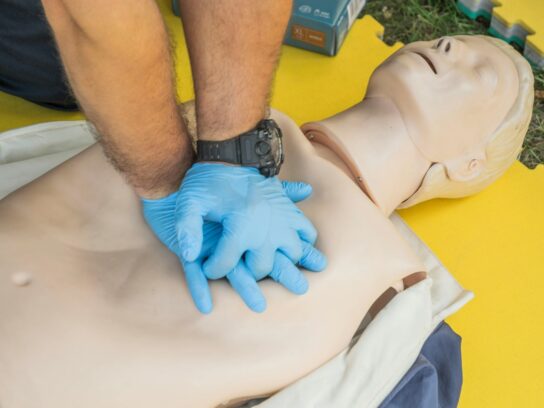
February is American Heart Month and the American Heart Association (AHA) is placing a special emphasis this year on training people to learn cardiopulmonary resuscitation (CPR).
The Heart Association estimates CPR often saves between 100,000 and 200,000 lives each year. CPR is used when someone goes into cardiac arrest and is unresponsive. A person performing CPR is manually pumping the heart to get oxygen flowing again to the patient’s body.
CPR Can Improve Survival Rate After Cardiac Arrest
MCM spoke with Dr. Ameya Kulkarni who is the associate medical director for Kaiser Permanente. He also serves as Board President for the American Heart Association in the Greater Washington Region.
Kulkarni said a person who suffers a heart attack is two to three times more likely to survive if given CPR right away. Kulkarni said the American Heart Association wants to create a nation of lifesavers.
“We want every single person in America to know CPR. It’s very simple. It’s easy to remember, and it absolutely will save a life,” Kulkarni said.
Different Approach to Learning CPR
In 2008, the American Heart Association changed its approach to teaching CPR. Years ago, people had to take classes and get certified in CPR, even if they were not in the medical field. During those sessions, people often would practice mouth to mouth breathing on a mannequin.
The American Heart Association decided to simplify its approach to teaching CPR to maximize the likelihood of survival. It created a 3-step method that is currently in use today.
The first step is to tap a patient on the shoulder to see if he or she is okay. When someone is in cardiac arrest, and not responding, that means the patient is not getting enough oxygen to his or her brain to be awake. The second step is for a person to immediately call 911 for help. The third step is to begin hands only CPR. That requires an individual to do chest compressions about 100 times a minute. The goal is to get the heart pumping again so that blood and oxygen will get to the brain.
“The 3-step method is designed to be so simple that somebody can teach it to you over the phone. It’s been an evolution, but I think it is a stroke of brilliance to recognize if you make CPR too complicated, people won’t do it. So certification is no longer required for what we call bystander CPR,” Kulkarni said.
“We always will still encourage people to get certified, but focusing on these three steps is by far the most important,” he added.
New Generation of Lifesavers
Maryland, Virginia, and the District of Columbia all require high school students to learn CPR by the time they graduate. Kulkarni said that is helping create a new generation of life savers.
A recent study conducted for the AHA found 39% of U.S. adults feel prepared to help in a cardiac emergency. The AHA says it still has more work to do especially among minority populations. The study from Decision Analyst found there are disparities in who receives CPR. For example women, Black and Hispanic/Latino Americans are less likely to receive CPR from bystanders. Overall, the AHA has set a goal of doubling the rate of survival following cardiac arrest by the year 2030.
Learning to Use an AED
Kulkarni believes individuals also should learn how to use an Automated External Defibrillator (AED). Former President Joe Biden signed the Hearts Act into law last year. The new law established a federal grant program to ensure schools and childcare centers have the resources they need to respond effectively to cardiac emergencies. That includes placing AED’s in schools, and providing CPR training to staff and students.
Kulkarni said having a cardiac emergency plan in schools and other public places is critical. That means making sure the AED’s have working batteries, people are trained to use them, and people know what to do if a cardiac arrest happens.
“The nice thing is AEDS have become incredibly smart, and so once you have the device in your hand, all you have to do is follow the instructions. It will tell you everything you need to do. They’re fabulous devices now. Thankfully cardiac arrests in children are not that common. An AED often can treat conditions that cause a cardiac arrest in a child,” Kulkarni said.
“We are committed at the American Heart Association to teach anyone how to create a cardiac emergency response plan and teach an individual or group of people CPR,” he added.
Combatting Heart Disease
Heart disease remains the number one killer of Americans. Kulkarni said it is important for people to understand their risk for developing heart disease. Four important factors determine a person’s risk. They include a person’s blood sugar, cholesterol, body mass index, and blood pressure.
“This is why we want everyone to know their numbers. These are controllable. Those are four things individuals can modify to lessen their risk,” Kulkarni said.
More Information
Meantime, the American Heart Association has a training video for people who want to learn CPR. Here is a link to that video:
Adventist Healthcare also offers CPR training. This includes the American Heart Association’s Heartsaver First Aid CPR and Infant Safety & CPR for parents.
For more information:


Comments are closed.